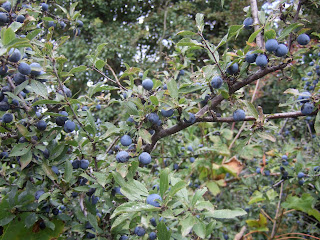Inspired by the efforts of my friend Rowan, I have spent the last ten days or so building up to the baking of a sourdough loaf.
You have to start a week or so in advance for this process if you are planning to make your own sourdough starter - alternatively if you have a generous friend who keeps their own starter, you may be able to beg some from them. Keeping the starter alive involves discarding half of it every couple of days - giving away to a friend or of course using it to bake a loaf - and adding fresh water and flour so there's always some spare hanging around.
Basically sourdough baking involves using natural yeasts to make your bread, and it takes a few days to get these yeasts going sufficiently to get your bread to rise. Mine didn't rise a lot, but the loaf did have a great flavour and some big holes inside it, so I'm hoping it will improve as my starter matures.
The first part of the process - finding some organic grapes/unoiled organic raisins with which to make the starter - was the most difficult part for me. Luckily another friend was given a box of such grapes by a neighbour, and once she had pulped them for their juice, I was the recipient of the skins and pips which I mixed with bread flour, rye flour and water in a loosely covered jar. However you don't need to use grapes or raisins at all - there are many different ways of making a starter, such as
this recipe from the River Cottage.
After several days of mixing, adding extra flour and water, straining, discarding various proportions etc, it was ready to use.
Making the loaf was a rather sticky, drawn-out process that is not complicated in terms of what you have to do, but it does involve relatively meticulous planning since the dough has to be left to sit for periods of time that vary from a whole day to 15 minutes. Quite simple if you are around the house all day, but fiendish if you need to fit it in around a working day, shopping, pilates class etc.
I found myself making the mix first thing in the morning, then leaving it to sit all day until I came home at night when I did the kneading. It then had to sit until it doubled in size - overnight was convenient since the following day I was at home. After that there's a period of folding, more rising and eventually baking - involving heating up the oven half an hour before you need it, spritzing water on the loaf to make a crust, making cuts in the top of it (why do mine never work?!) and so on.
Although the bread had a fabulous taste and big air holes inside it, in terms of shape it looked more like a bread biscuit than a loaf. I found it almost impossible to get the dough into any kind of loaf shape. Next time I intend to try baking it in a casserole dish with the lid on.
There's a couple of good articles
here and
here about maintaining a starter and baking.































































